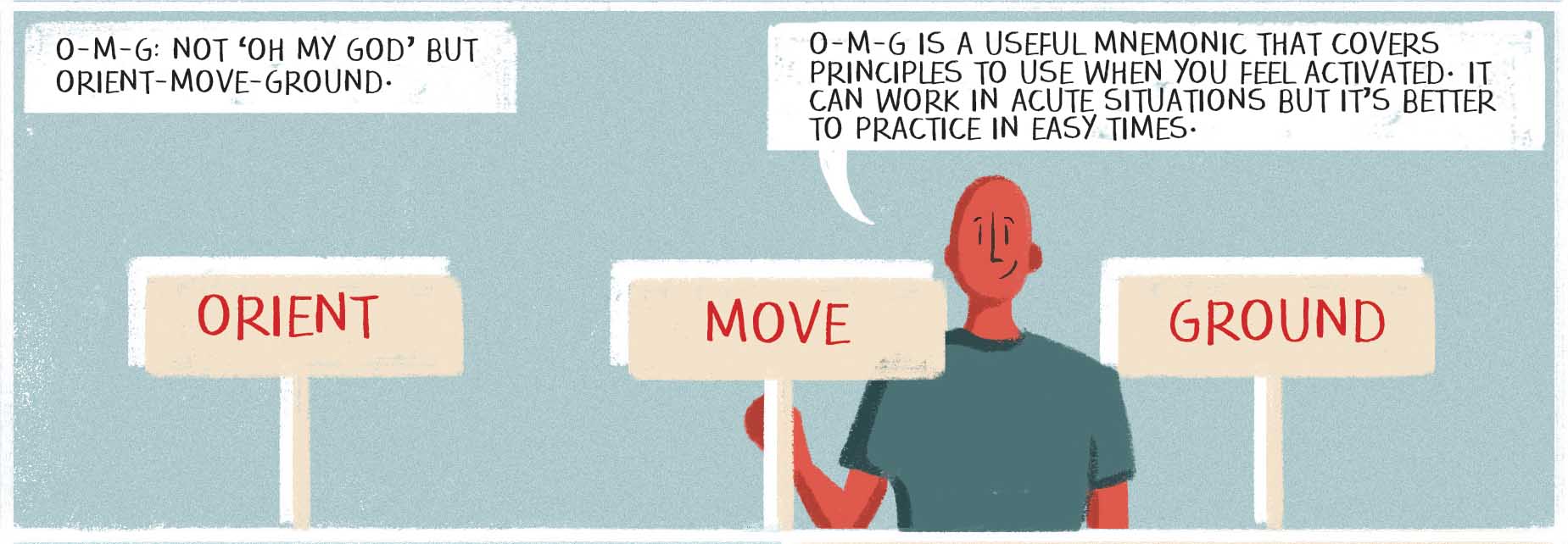
Orient Move Ground for self regulation when feeling activated
OMG is a mneumonic to help remember responses to contain feelings of activation. OMG works as a set of principles for therapists and individuals.
- Probably best to avoid going ‘Oh My God’, try Orient, Move and Ground
- It’s scary when we get activated. Catastrophic thoughts can take over.
- Activation, as used here, means increasing arousal is triggered by our threat detection systems. We all have an inner guard dog, networks that are part of our nervous system that are always checking ‘Am I Safe’?
- Threat detection leads to protective reflexes. Stephen Porges teaches there is a progressive action of the autonomic nervous system (ANS): social engagement (we seek safety in others, change in new vagal complex), mobilisation (we seek safety by speeding up; ‘fight-or-flight’, activate sympathetic nervous system), immobilisation (we seek safety by withdrawing; ‘freeze’, dissociation, activate old vagal complex)
Focus on the principles
- Creating safety by balancing the ANS: down regulate the sympathetics, increase activity in the new vagus
- Present time sensations is the goal
- Safety via embodiment
- Titration: A little and often is the best way to work with overwhelm
- Put the brakes on anything going to quick or any sense of disappearing
- Principles not protocols – be creative
O Orient
- Go Slow: Pause and give time. Acknowledge what is happening: ‘I notice there is a big charge here’ or ‘I notice there is an urge to go quick’ or ‘I notice it seems hard for to be here, it is easy to drift away’
- Orient to a safe person. Find someone you trust (a supporter) to help you come in to safety. For therapists/ supporters; you need to be the safest thing in the room, the therapist needs to be present. Skills for the therapist/supporter include; use a low, slow voice, lots of eye contact and authentic facial expression, hand holding can be really useful.
- Orient to the environment: Can you hear the rain or wind? How many lights can you see above you? Do you like the pictures on the wall? Do you like the earrings/ jumper of the person you are with. Distract yourself away from the edge of fear.
M Move
- Mobilise out of immobilisation
- Can you wiggle your toes, tense legs, tense arms?
- Use new strong movements to generate sense of power in the limbs. Push your feet into the floor, push your hands together.
- Visualise slowly completing frozen movements
- Sit up and walk around if needed
- Take control and stop cycling processes, instead of pausing you may need to be nimble and quick to break the cycling overwhelm
G Ground
- Body: Orient to body sensations. Out of thinking and emoting into safe sensations. How does that feel in your body right now? Simple descriptive words, avoid interpretation
- Can you feel your feet? Downward focus away from hot, active, busy head. Can you feel your belly? Can you feel the back of your body?
- Check the weight, size and shape of limbs
- Anything that helps you come into the present moment
- Change your breathing pattern – make long slow out breaths to stimulate the new vagus, hold your breath.
- Self Touch: Hand on belly, hand on heart, rubbing hands, self squeezing down limbs
Haines S (2015) Touch Is Really Strange. Singing Dragon JKP. https://bodycollege.net/trauma/